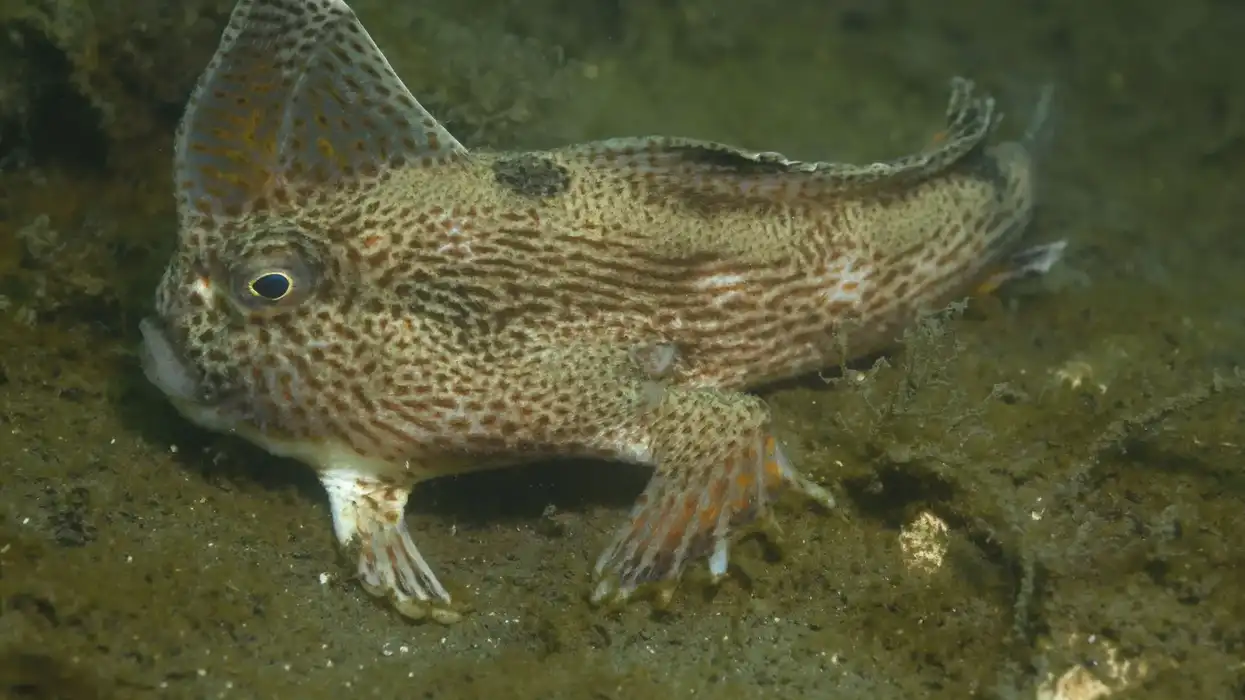Sailfish are best known as the fastest fish in the ocean, reaching speeds of 70 mph (112 kph)! They are spread over a wide geographic (tropical and temperate) range and are top predators, feeding on prey such as sardines, anchovies, squid, and octopus, as well other small school fish in the ocean.
The most recognizable parts of their bodies are their extended bills and huge sail-like dorsal fins.
A sailfish may use its bill to stab prey and its dorsal fins allow the fish to navigate ocean waters at high speeds. They live close to the surface but may dive much deeper looking for other fish in the ocean.
They face competition for the title of the fastest fish from swordfish and blue marlins.
They breed in large numbers, with the female laying as many as 5 million eggs annually. Fishers often try to catch and capture sailfish as trophy fish due to their huge sizes, their novel physical features, and their natural beauty.
They are not caught for their meat, outside of the local coasts that they are found near.
Not many species are known for feeding on sailfish, except for much larger fish such as common dolphins, sharks, and orcas. Since their numbers are not under any immediate threat, sailfish are classified as a species of Least Concern by the International Union for Conservation of Nature.
Learn more about some other fish including codfish or catfish here.
Sailfish Interesting Facts
What type of animal is a sailfish?
The sailfish is a type of fish.
What class of animal does a sailfish belong to?
The sailfish belongs to the fish (Actinopterygii) class of animals.
How many sailfish are there in the world?
The exact number of sailfish in the world has not been determined, since their populations are abundant over a wide range.
Where does a sailfish live?
Sailfish live in the ocean, in shallow waters, near the surface.
What is a sailfish's habitat?
Sailfish are found in the open, warm, and temperate waters of different oceans. They live in waters that are shallow enough to get plenty of sunlight but sometimes may go deeper, as much as 1,150 ft (350 m) for prey. They do not live very near the coast.
Who does a sailfish live with?
Sailfish may live alone or in a small group.
How long does a sailfish live?
A sailfish may live for 13-15 years.
How do they reproduce?
Sailfish reproduce via external fertilization, meaning the female and male release their eggs and sperms respectively into the water column. The female will release millions of eggs at a time, and about 5 million annually. The eggs hatch about 60-70 hours after fertilization.
What is their conservation status?
The conservation status of sailfish according to the International Union for Conservation of Nature is Least Concern.
Sailfish Fun Facts
What does a sailfish look like?
A sailfish's length is 51.18-63.78 in (130-162 cm), and it has a height of 13-20 in (33-50.8 cm). Some of them grow up to be as big as 134 in (3.4 m).
Being one of the fastest fish, it has a long and streamlined body, which allows it to easily achieve the high speeds that it does. Sailfish are usually a dark blue color, with shades of brown and a lighter blue.
The ventral sides are a whitish-silver color. Sailfish bear a resemblance to billfish, but sailfish have up to 20 light blue dotted stripes adorning their frontal sides.
The length of a sailfish's bill can be as much as 12 in (30 cm). Sailfish teeth are sharp and pointed. Most prominently, sailfishes have a huge dorsal fin that looks like a sail.
This primary dorsal fin has 42-49 rays whereas a second, much smaller dorsal fin has six or seven rays. Their pectoral fins have 18-20 rays and are long and curved.
Their pelvic fins have a length near 3.9 in (10 cm). Their large dorsal fin is responsible for their exceptional swimming speeds, and they may fold it down for decreasing any drag while cruising.

How cute are they?
Sailfish are basically kings of the ocean. They are spread over a wide geographic range and are a group of top predators, hunted only by marine animals with bigger bodies than themselves.
They have beautiful, regal bodies and they are the fastest fish in the ocean. Their long bills and huge dorsal fins give them a striking, instantly recognizable appearance. They may not be 'cute', but sailfish are definitely graceful and magnificent creatures.
How do they communicate?
Sailfish may change or flash their colors to communicate with other sailfish or they sometimes move their dorsal fins. They also have nares that detect chemicals. They are also capable of hearing and sensing movement, and seeing with their eyes. They sense movement and pressure changes via a lateral line.
How big is a sailfish?
A sailfish is 51.18-63.78 in (130-162 cm) long and 13-20 in (33-50.8 cm) in height, which makes it three to five times bigger in size than the Alaska pollock.
How fast can a sailfish move?
The sailfish is the fastest fish in the ocean and the world, moving at maximum speeds of around 70 mph (112 kph).
How much does a sailfish weigh?
A sailfish weighs around 110.13-220.26 lb (50-100 kg).
What are the male and female names of the species?
Males and females of the sailfish species do not have specific names.
What would you call a baby sailfish?
A baby sailfish may be called a 'juvenile' or a 'fry'.
What do they eat?
Sailfish prey on sardines, anchovies, octopus, and squid. They are also known for feeding on other smaller fish throughout their life. A sailfish often uses its bill to stab at and kill prey.
Are they poisonous?
No, sailfish are not poisonous.
Would they make a good pet?
No, sailfish would not make a very good pet. They are very big creatures and the fastest fish in the world. It would not be possible to provide a habitat for them outside of the ocean.
Did you know...
Although the sailfish is considered a Least Concern species, there is a need to address the deficiency of data on sailfish that live in the Indian Ocean and the Pacific Ocean.
The Indian Ocean Tuna Commission considers this fish to be a data-deficient species, and there may be increased pressure on the fishing of sailfish in the Indian Ocean. In Indo-Pacific waters, there may be more than one country fishing for the sailfish.
Fishing for these fish isn't easily accomplished, due to their length, size, weight, and the defensive features of their body.
Although sailfish are found over the entire world, they prefer warmer ocean water over cold ocean water. The Indian, Pacific, and Atlantic oceans have abundant populations of sailfish, but not the Arctic Ocean.
Sailfish are related to marlins and they both have links to the billfish family, Istiophoridae. True billfish also include the swordfish and different spearfish. Other billfish-like fish include pipefish and saw sharks.
Atlantic sailfish have similar diets to the Indo-Pacific sailfish; they eat mackerel and cephalopods in addition to sardines and anchovies. The name Istiophorus albicans is used specifically for Atlantic sailfish, and Istiophorus platyperus could be used collectively or for the Indo-Pacific sailfish alone.
The Upper Keys in Florida is reported to be a good sailfish catching site.
Swordfish do not attack humans without being provoked. When fishermen try to catch swordfish, they can be dangerous and may cause serious injury through their 'swords' or bills. Such incidents are rare, but a noteworthy incident occurred in 2015 when a man was tragically killed by a broadbill swordfish in Hawaii.
Sailfish are able to jump at least the entire length of their bodies which means they can jump 10 ft (30 cm) or more out of the water, if not more!
In the USA, the NOAA Fisheries or the National Marine Fisheries Service has prohibited removing a sailfish out of the water. A recreational fisher can be fined $500 for violating this rule.
Only people with actual licenses and permits can catch and harvest a sailfish, but only if it has a jaw length longer than 63 in (1.6 m), and they too must report it.
Is a sailfish faster than a swordfish?
Yes, the sailfish is definitely faster than the swordfish. To get an idea of sailfish vs swordfish speeds, the top recorded speed of swordfish is around 60 mph (97 kph), whereas the top sailfish speed can easily reach up to 70 mph (112 kph).
Both are among the fastest fish recorded and marlins are among the fastest fish besides these two, achieving top speeds of 68 mph (110 kph).
Can you eat a sailfish?
Sailfish are edible but aren't a widely eaten food. They are very meaty and tough and aren't very palatable. They aren't widely consumed or prepared outside of local areas.
Here at Kidadl, we have carefully created lots of interesting family-friendly animal facts for everyone to discover! Learn more about some other fish from our swai fish facts and skate fish facts pages.
You can even occupy yourself at home by coloring in one of our free printable sailfish coloring pages.









